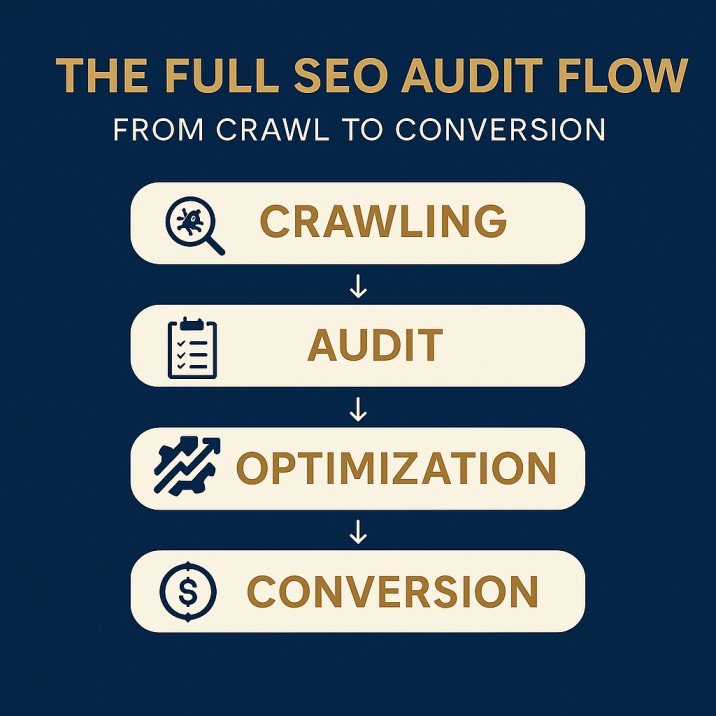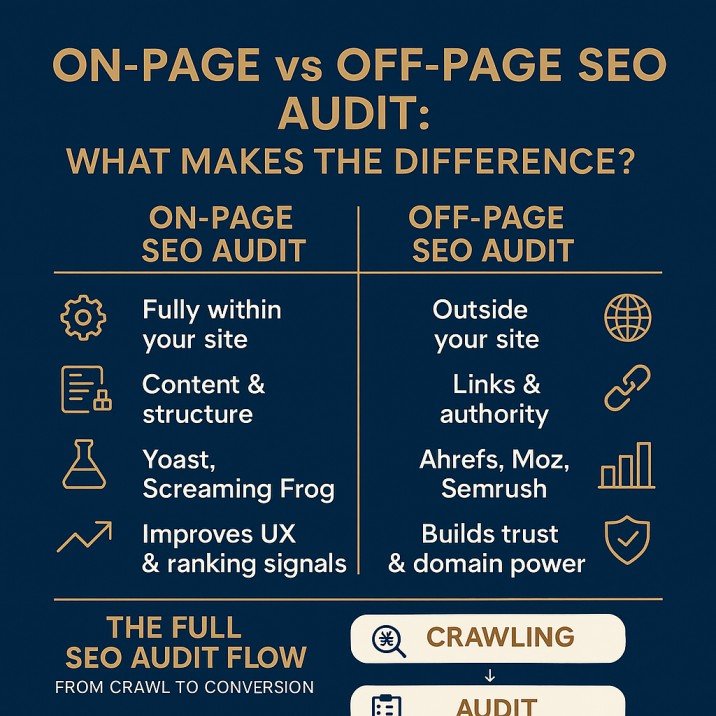By conducting regular audits SEO becomes one of the most critical components of a successful digital marketing strategy. It is one of the best ways to assess your site’s performance, what’s working, and what needs fixing. Audit website for SEO lets you find technical problems, gaps in content, and where you need the SEO audit checklist for the all-important google ranking. For this reason, this guide provides a complete list of steps you will need to follow, along with the best website audit free tools and tools for website SEO audits to help you with your complete website SEO audits including on-page SEO audits and off-page SEO audits for 2025.
What is an SEO Audit, and Why Does It Matter?
A website SEO audit is an in-depth evaluation of every facet available on your site, including the technical aspects, performance, and authority. Businesses that conduct regular audit website for SEO, learn about hidden issues that may be hurting their performance, like broken links, poor mobile responsiveness, or weak backlinks.
Routine audits SEO allows you to keep your content synced with your audience’s intent and the algorithms of search engines. Having a comprehensive SEO audit checklist allows you to examine every detail, including metadata and links.
Step 1: Prepare Your SEO Audit Checklist
Before you begin, having a systematic SEO audit checklist is essential. An audit checklist guides your audit and ensures its proper organization. Always be sure to record:
- Crawling and indexing
- Keyword
- backlinks and content
- User experience.
Seasoned professionals audits SEO know the importance of consistency. As a result, ensure your SEO audit checklist is thorough, current, and adhered to, as you will be budgeting your time effectively for audit website for SEO.
Step 2: On-Page SEO Audit – Optimizing What’s On Your Site
Your on-page SEO Audit concerns all things visible to both the user and the crawlers. Again, your focus should be the improvement of your content structure, keywords, and user experience. Check the following:
- The meta title and description,
- The correct header hierarchy (H1, H2, H3),
- The ALT text and picture size,
- The depth of the content and the internal linking should also be carefully considered.
When conducting an On-Page audits seo, please ensure you also consider the readability, mobile-friendliness, and engagement level of the material. For your On-Page SEO audit, you can use SEO audit tools like Yoast, Screaming Frog, and Rank Math. A solid on-page SEO audit demonstrates to stakeholders that your site is technically clean and user-oriented.
Step 3: Off-Page SEO: Diversifying Your Website Authority
Off-page SEO audit translates to how your website interacts with other websites and how other websites promote your website with linkbacks, brand mentions, and domain authority.
- Please review the quality and variety of your backlinks.
- Use SEO audit tools to find harmful links.
- Make sure that citations are consistent on business directories.
- Make your brand references and trust signals stronger.
When you audit website for SEO, an off-page SEO audit helps you evaluate your link-building success and discover new outreach opportunities. Regular audits SEO make your off-site strategy more powerful.
Step 4: Technical Website SEO Audit
A technical website SEO audit dives deeper into backend problems that may create issues when crawlers access your site and index it. Start using the fine-tuned technical SEO service of ShreyWeb and give your business a boost.
- Fix broken links and redirects
- Test page speed and mobile performance
- Optimize site structure and internal linking
- Review HTTPS, canonical tags, and sitemap.xml.
You can use SEO audit tools like Google Search Console, GTmetrix, and Semrush. A thorough website SEO audit ensures your pages load fast and rank efficiently.
“The Full SEO Audit Flow: From Crawl to Conversion”

Step 5: The greatest free website audit tools for acquiring the right information
If you don’t want to spend a lot of money, you could want to think about using free website audits SEO tools that are very powerful.
- Google Search Console tells you how many pages your site has and how well it is indexed.
- Ahrefs Webmaster Tools lets you keep track of keywords and backlinks.
- Ubersuggest shows you how many keywords there are and how hard they are to get.
- GTmetrix: Making pages load faster and work better.
- Screaming Frog (Free Version): On-page data analysis.
These website audit free tools work alongside premium SEO audit tools to give detailed and actionable insights when you audit website for SEO.
Step 6: Create and Implement Your SEO Action Plan
After completing your SEO audit checklist, organize your findings by priority.
- Resolve technical issues first.
- Reoptimize outdated content.
- Improve backlinks and citations.
- Monitor analytics for post-audit progress.
To keep your website SEO audit effective, repeat the process quarterly. Regular audits SEO build consistency and keep your website aligned with best practices.
“On-Page vs. Off-Page SEO Audit: What Makes the Difference?”

Step 7: Combine On-Page and Off-Page Insights
Your on-page SEO audit and off-page SEO audit must work together.
- Link keywords to backlink anchors.
- Coordinate how you use internal and external links.
- Develop content that people will want to share and that also supports the content audits.
This overall method improves the foundation of your SEO. When you conduct an SEO reason audit website for SEO, checking these areas provides a full 360 optimization view.
Step 8: Pro tips to make your SEO audits more effective
- Conduct an SEO audit of your site every 3 to 6 months.
- After every on-page SEO audit, analyze the keyword positions.
- Implement automation in your SEO audit to accelerate the process.
- Utilize free website audit tools to analyze your data over an extended period.
- Stay up to date – SEO is always changing.
Check out how to drive more local leads with SEO services to boost your site’s visibility and conversions.
Step 9: Mistakes to avoid
Many companies make the same mistakes when audits SEO, for instance, forgetting about technical SEO and not documenting the problems. Common mistakes include:
- Not optimizing for mobile.
- Check the backlinks in your off-page SEO audit.
- You should also pay attention to the metadata in your on-page SEO audit.
- You are neglecting the importance of site speed and Core Web Vitals.
Conducting regular website SEO audit will help you avoid these mistakes and unhealthy sites.
Conclusion
When it comes to audits SEO, the more frequent, the better! While website audit free tools are time-consuming, the right mix of free diagnostic tools and professional SEO audit tools will deliver impressive, results-driven audits. Using this SEO audit checklist, you are bound to improve the visibility, UX, and conversion of your website.
When done strategically, the audit website for SEO process is no longer a mundane task but rather a foundational component of your digital success. For more information contact US today.
FAQs
Q.1 What is the main purpose of audits SEO?
To improve your website ranking on the search engine result pages, the first step is to uncover and resolve the technical, on-page, and off-page constraints isolating your site.
Q.2 How often should I audit website for SEO?
To stay on top of your site’s performance, SEO best practices recommend quarterly audit website for SEO to ensure your site complies with current Google ranking updates.
Q.3 What are the best website audit free tools?
When it comes to website audit free tools for technical audits, on-page, and backlink reviews, Google Search Console, Ubersuggest, Screaming Frog, and GTmetrix remain top free website audit tools.
Q.4 What’s the difference between an on-page SEO audit and an off-page SEO audit?
On-page SEO audits examine your site’s content and its internal structure. Off-page SEO audits look external, assessing your backlinks, citations, and other authority signals that come from outside your site.

